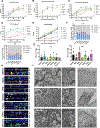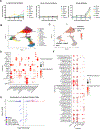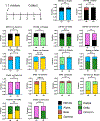SARS-CoV-2 variant of concern fitness and adaptation in primary human airway epithelia
- PMID: 38607917
- PMCID: PMC11165423
- DOI: 10.1016/j.celrep.2024.114076
SARS-CoV-2 variant of concern fitness and adaptation in primary human airway epithelia
Abstract
The severe acute respiratory syndrome coronavirus 2 pandemic is characterized by the emergence of novel variants of concern (VOCs) that replace ancestral strains. Here, we dissect the complex selective pressures by evaluating variant fitness and adaptation in human respiratory tissues. We evaluate viral properties and host responses to reconstruct forces behind D614G through Omicron (BA.1) emergence. We observe differential replication in airway epithelia, differences in cellular tropism, and virus-induced cytotoxicity. D614G accumulates the most mutations after infection, supporting zoonosis and adaptation to the human airway. We perform head-to-head competitions and observe the highest fitness for Gamma and Delta. Under these conditions, RNA recombination favors variants encoding the B.1.617.1 lineage 3' end. Based on viral growth kinetics, Alpha, Gamma, and Delta exhibit increased fitness compared to D614G. In contrast, the global success of Omicron likely derives from increased transmission and antigenic variation. Our data provide molecular evidence to support epidemiological observations of VOC emergence.
Keywords: CP: Microbiology; SARS-CoV-2; adaptation; cellular tropism; competition; coronavirus; primary airway culture; recombination; single cell RNA-seq; variants of concern; viral fitness.
Copyright © 2024. Published by Elsevier Inc.
Conflict of interest statement
Declaration of interests R.S.B. is a member of advisory boards for VaxArt, Takeda, and Invivyd; has consulted for Gilead; and has collaborative projects with Gilead, J&J, and Hillevax focused on unrelated projects.
Figures





References
-
- Sheahan TP, Sims AC, Zhou S, Graham RL, Pruijssers AJ, Agostini ML, Leist SR, Schafer A, Dinnon KH, Stevens LJ, et al. (2020). An orally bioavailable broad-spectrum antiviral inhibits SARS-CoV-2 in human airway epithelial cell cultures and multiple coronaviruses in mice. Sci Transl Med 12, 1–20. 10.1126/SCITRANSLMED.ABB5883. - DOI - PMC - PubMed
Publication types
MeSH terms
Supplementary concepts
Grants and funding
- R01 HL153375/HL/NHLBI NIH HHS/United States
- U19 AI116484/AI/NIAID NIH HHS/United States
- R01 HL146557/HL/NHLBI NIH HHS/United States
- P01 HL108808/HL/NHLBI NIH HHS/United States
- P30 DK065988/DK/NIDDK NIH HHS/United States
- P30 ES010126/ES/NIEHS NIH HHS/United States
- R01 AI110700/AI/NIAID NIH HHS/United States
- R01 HL160939/HL/NHLBI NIH HHS/United States
- R03 HL155249/HL/NHLBI NIH HHS/United States
- P30 CA016086/CA/NCI NIH HHS/United States
- U01 HL156655/HL/NHLBI NIH HHS/United States
- U54 CA260543/CA/NCI NIH HHS/United States
- P01 HL164320/HL/NHLBI NIH HHS/United States
- K08 HL143271/HL/NHLBI NIH HHS/United States
- R01 HL163602/HL/NHLBI NIH HHS/United States
- P30 CA014236/CA/NCI NIH HHS/United States
- U19 AI171292/AI/NIAID NIH HHS/United States
LinkOut - more resources
Full Text Sources
Other Literature Sources
Medical
Molecular Biology Databases
Miscellaneous

